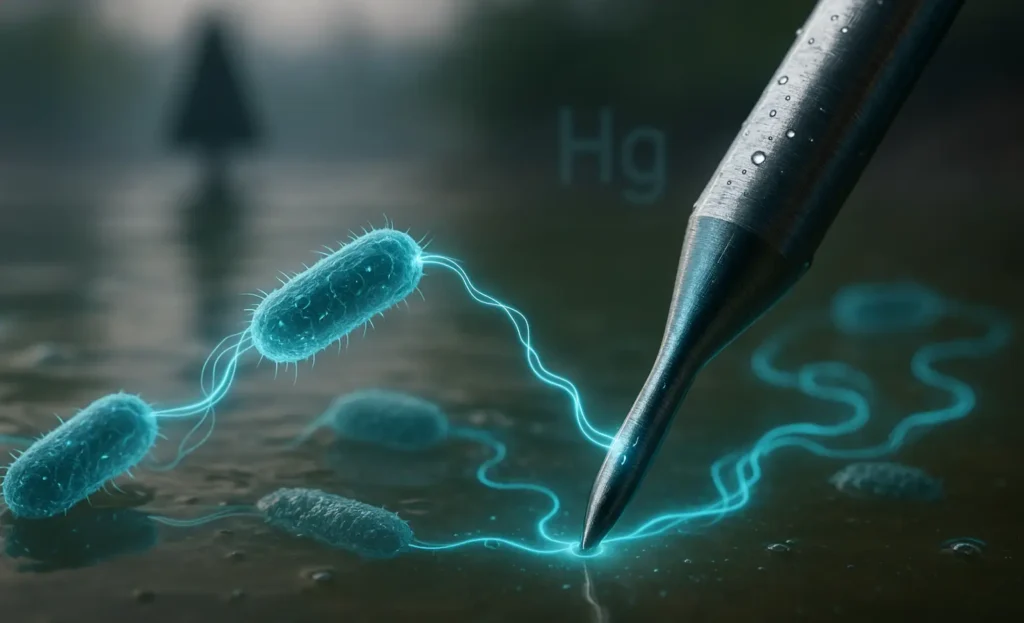Mercury is a deceptively small molecule problem with continent-scale consequences—and the current testing pipeline is slow, centralized, and expensive. The new twist is radical but practical: turn engineered E. coli into self-powered, programmable biosensors that detect mercury and output electrical signals readable by cheap electronics, shrinking lab-grade detection into a field-deployable ecosystem. This is less a new gadget and more a new layer of infrastructure—biology that speaks in voltage, stitched into the workflows of utilities, regulators, and frontline communities.

How the Living Sensor Works
Genetic Sensing And Signal Transduction
At the core is a modular genetic design: a sensing module tuned to mercury ions, a processing/amplifier module that boosts the response, and an output module that produces redox-active molecules measurable by voltammetry. In practice, the cell becomes a biotransducer: mercury binds a regulator, gene circuits fire, phenazines are produced, and an electrode reads a current within hours.
From Presence To Policy-Relevant Sensitivity
The amplifier enables trace detection below WHO thresholds, moving from a coarse “presence/absence” readout to actionable sensitivity in real water matrices. This enables earlier warnings and more granular compliance decisions at the edge.
From Lab Bench To Field Box
Electrical Output Over Optical Readouts
Most whole-cell biosensors historically talk in light, which is hard to integrate into rugged, low-cost devices; electrical outputs plug directly into simple potentiostats or embedded boards. This alignment makes ruggedization and telemetry simpler and cheaper than optical rigs in the field.
Cartridge, Electrode, And Reader
A ruggedized cartridge holding stabilized cells mates to a stainless-steel or carbon electrode, logging current signatures in situ without optical alignment. This reframes deployment from specialist sampling to distributed sensing along pipelines, tailings ponds, and community taps.
Why Mercury, Why Now
The Public Health Imperative
Mercury contamination travels with artisanal mining, coal combustion, and industrial processes, and methylmercury biomagnifies in food webs. Small communities and subsistence fishers bear disproportionate risk when detection is delayed or sparse.
Limitations Of Centralized Testing
Cold vapor AAS and ICP-MS are accurate but centralized and slow, which delays responses and erases local variability. A living sensor offering sub-threshold detection in 2–3 hours shifts the cadence from quarterly reports to near-real-time dashboards.
Ecosystem Integration: Devices, Data, Decisions
Hardware Layer
- Low-cost electrochemical readers and swappable cell cartridges fit inside meter boxes or buoy-mounted nodes.
- Electrical readouts reduce power draw and simplify wireless telemetry compared with optical systems.
Data Layer
- Time-stamped current signals map to mercury concentrations after calibration to build spatiotemporal maps.
- Cloud analytics trigger threshold alerts aligned with local and WHO guidelines.
Decision Layer
- Utilities can route flushing, switch intakes, or dose adsorbents in response to spikes.
- Health agencies can issue targeted fish advisories; regulators can enforce discharge permits with event-based evidence.
Second-Order Effects Across Industries
Water Utilities
Shift from periodic lab sampling to continuous sentinels, reducing blind spots and shortening response times after rainfall or process upsets.
Mining And Industrial Operations
Event-driven compliance increases accountability via dense monitoring arrays, nudging investment in source control and closed-loop systems.
Insurance, Finance, And ESG
Real-time exposure data feeds risk models, potentially lowering premiums for facilities adopting continuous monitoring while elevating scrutiny for laggards.
Consumer And Civic Tech
Portable, phone-paired readers plus sealed cartridges could enable community science and local journalism, similar to the civic impact of air-quality monitors.
Comparative Landscape And Future Upgrades
Multiplexed Bioelectronic Sensing
Sister work encodes multiple metal-ion signals into distinct electrochemical signatures, then decodes them for simultaneous calls. A mercury channel can slot into the same framework to monitor co-occurring metals from a single node.
Cost And Throughput Advantages
Multiplexing improves throughput and reduces per-analyte costs for field deployments, enabling basin-wide coverage with fewer devices.
Reliability, Safety, And Standardization
Operational Robustness
Cell stability across temperatures, electrode fouling, and drift demand calibration routines, replaceable consumables, and scheduled maintenance. Robust QA/QC with spikes, blanks, and cross-reactivity panels underpins trustworthy data.
Biosafety And Containment
Genetic containment (auxotrophies, kill switches) and sealed cartridges minimize environmental release risk. Clear protocols for handling spent cartridges and waste streams are essential for adoption.
From Pilot To Policy
Early Deployment Pathways
Mining belts and industrial corridors with episodic releases are ideal for early pilots. Partnerships among universities, utilities, and agencies validate field performance against lab gold standards.
Procurement And Scale-Up
Over time, procurement can fold “bioelectronic sentinels” into SCADA upgrades and asset management plans, moving beyond one-off research gear to durable infrastructure.
What Success Looks Like In Five Years
A river basin stitched with discreet nodes reports electrical signatures of mercury alongside other metals, triggering automated samplers and community alerts. Facility managers receive real-time excursions; regulators see time-resolved compliance; residents check a map before cooking fish—the engineered cells quietly convert a toxic trace into an actionable line on a graph.
Pragmatic Limitations And Honest Caveats
No single sensor is a panacea: matrix effects, competing ions, and biofouling can dampen signals or introduce false positives without QA/QC. Cold-chain-free stability and multi-month cartridge life remain hurdles, and detection does not equal remediation—policy and infrastructure must close the loop.




